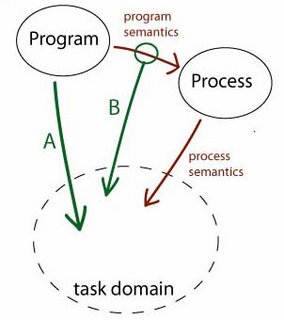
For Sorensen "the addition of program semantics to live performance is the primary reason to program in real time." Live coding transforms the two-stage chain that Cantwell Smith describes, because it introduces the program semantics into the task domain. In the modified version of Cantwell Smith's diagram above it's marked B. This is important: it's not just the displaying of the program code, but the playing out of the relationship between code and process / behaviour. In a live coding performance where we see code and hear sound, we are presented with the task of understanding the relation between the two - inferring or mapping the generative relation between code and sonic output. The specific relation may have a semantics of its own in the "task domain" of performance - it's not simply what you do, but also how you do it. There's also the semantics of the code itself, in relation to the task domain (A): this seems less interesting to me, but related to the code-focused theory around software art - see for example Inke Arns' paper (Runme 2004).
No comments:
Post a Comment